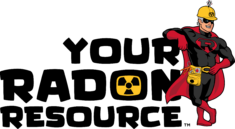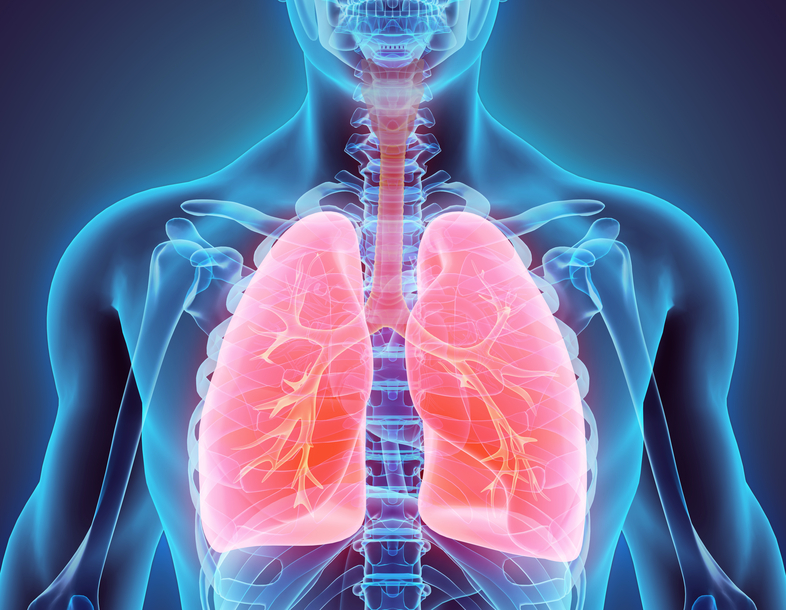How Does Radon Induce Cancer?
Radon presents a hazard in two ways. As it decays, it gives off energy in the form of alpha particles. Alphas aren’t generally much of a threat unless they are inhaled. When a person breathes in radon gas, the energy from the decaying particles can damage DNA in the cells of the lungs. In addition to its emission of radioactive alpha particles, radon poses a risk because it decays further into daughter atoms like polonium 214 and polonium 218. These radon daughters are solid and can attach to tiny particles that we breathe in. Some of these particles stick to the layer that line the lungs. As the unstable polonium atoms next to the lung tissue decay, they emit still more radioactive energy inside us which can contribute to the series of mutations which lead to cancer.
What are “picoCuries”?
The concentration of radon gas is not measured directly but rather by the radioactivity it produces. It is expressed in picoCuries per liter of air, or “pCi/L”. A Curie is a unit of radioactivity equivalent to 1 gram of radium and the prefix “pico” means a trillionth. In the metric system, radon concentration is expressed in Becquerels per cubic meter (Bq/m3). One Becquerel means one radioactive disintegration per second, and 4 pCi/L equals to 148 Bq/m3. In an average basement, 38 million atoms will undergo radioactive decay each hour.
CALL NOW – These Radon Testers below are Highly Recommended:
How about all the other radiation around us?
Background radiation levels are a combination of terrestrial (radium, thorium, radon, etc.) and cosmic radiation (photons, muons, etc.) Natural radioactivity is common in the rocks and soil that make up our planet – over 60 radionuclides (radioactive elements) can be found in nature.
Sunshine is a radiation. The visible light is in the middle of its range of wavelengths. The long-wave radiation is infrared and it warms the skin. The shortest wavelength is ultraviolet radiation which causes skin cancer.
Beyond the ultraviolet radiation is a higher-frequency radiation emitted from nuclei of unstable radioactive atoms – ionizing radiation. It has enough power to knock out electrons from atoms and convert them to electrically charged ions, which can damage the large molecules of living cells. Ionizing radiation damages DNA and just one mutant cell can cause cancer. There are several types of ionizing radiation:
- Alpha particles consist of two protons and two neutrons (like the nucleus of helium) and can pack a microscopic wallop when they collide with molecules. Because of their relatively large size, alpha particles collide readily with matter and therefore do not penetrate deep. Because they give up their energy over a relatively short distance, alpha particles can inflict more biological damage than any other radiation.
- Beta particles are fast-moving electrons (or even the anti-matter positrons) ejected from the nuclei of atoms. Being much smaller than alpha particles, they can penetrate up to 1 to 2 centimeters of water or human flesh.
- X-rays and gamma rays are pure energy transmitted in a wave without the movement of matter, just as light photons. But unlike light, they have great penetrating power and easily pass through the human body. Gamma rays emitted from nuclei are similar to x-rays but more energetic.
Radon decay chain offers a full menu of ionizing radiation: alpha and beta particles, and gamma rays. (Nuclear explosions emit one more radiation – neutrons.) Cosmic radiation consists of a variety of very energetic particles, including protons, muons, and neutrinos, which bombard the earth from outer space. Radioactivity is all around us and also within us.
However, two thirds of the total effective radiation dose to the average American from all natural sources comes from radon and its progeny. Radon in homes is more concentrated and far more dangerous than outdoors – the National Academy of Sciences estimates that the outdoor radon causes only 800 out of the total of 21,000 lung cancer deaths caused radon in the US each year.
EPA did not want to force homeowners to install costly radon mitigation systems, leaving the decision up to each homeowner. But at the same time, EPA has made it clear that the 4 pCi/L action limit is not a “safe” level and warned the public:
Any radon exposure has some risk of causing lung cancer. The lower the radon level in your home, the lower your family’s risk of lung cancer.
Unlike radon levels in homes, occupational radon limits are governed by law and regulations. The Miners Safety and Health Act (MSHA) covers underground miners. Their annual exposure is limited to less than 4 WLM (Working Level Months), equivalent to 33 pCi/L during their working hours. The Occupational Safety and Health Act (OSHA) limits cumulative radon exposure in the workplace to 30 pCi/L based on 40 working hours per week. Assuming the highest radon level in modern mines, the average person receives in his home at 4 pCi/L over 12 years the same radiation dose as if he/she worked for 5 years in a uranium mine.
What is a carcinogen?
Cancer is caused by changes in a cell’s DNA – its genetic “blueprint.” Some of these changes may be inherited from our parents, while others may be caused by outside exposures, which are often referred to as environmental factors. Environmental factors can include a wide range of exposures, such as:
- Lifestyle factors (nutrition, tobacco use, physical activity, etc.)
- Naturally occurring exposures (ultraviolet light, radon gas, infectious agents, etc.)
- Medical treatments (chemotherapy, radiation, immune system-suppressing drugs, etc.)
- Workplace exposures
- Household exposures
- Pollution
Substances and exposures that can lead to cancer are called carcinogens. Some carcinogens do not affect DNA directly, but lead to cancer in other ways. For example, they may cause cells to divide at a faster than normal rate, which could increase the chances that DNA changes will occur.
Carcinogens do not cause cancer in every case, all the time. Substances labeled as carcinogens may have different levels of cancer-causing potential. Some may cause cancer only after prolonged, high levels of exposure.
EPA recommends that any home or business consider fixing the property if the radon results are 2.5pCi/L to 3.9pCi/ L. These levels, while acceptable, can still be a danger to some people. Please look for more information on this important subject on the EPA’s web site.
And for any particular person, the risk of developing cancer depends on many factors, including how they are exposed to a carcinogen, the length and intensity of the exposure, and the person’s genetic makeup.
Q:
With respect to radon, what does the term “plated out” mean?
A:
This answer assumes that the “radon” being referred to is 222Rn. Nevertheless, the answer would not be materially different if we were considering 220Rn (thoron). Radon is a noble gas. When it decays, it produces four short-lived decay products: 218Po, 214Pb, 214Bi and 214Po. All of these are solids. For the most part, these decay products attach themselves to airborne particulates. When the particulates are deposited on surfaces such as walls and floors, we say that the associated radon decay products are plating out. The magnitude of the plate-out depends, among other things, on the nature of the air currents and the types of surfaces that are available. For example, surfaces with a static charge are particularly effective at accumulating radon decay products. It should be mentioned that the “unattached” radon decay products (those not attached to airborne particulates) are also subject to plating out. The radon itself, being an unreactive noble gas, does not plate out on surfaces. Instead, it remains in the air. Paul Frame, CHP, PhD

